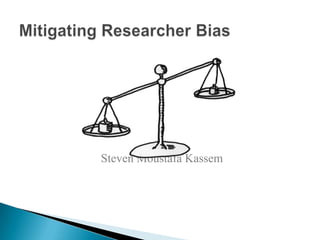
Biases
- 3. unknown or unacknowledged error created during the design, measurement, sampling, procedure, or choice of problem studied
- 4. ◦ bias is so pervasive because we want to confirm our beliefs ◦ science is organized around proving itself wrong not right ◦ key difference between qualitative and quantitative research is attempts to eliminate bias by quantitative researcher explicit acknowledgement of bias by qualitative researchers
- 5. when the study fails to identify the validity problems when publicity about the research fails to incorporate the researchers cautions
- 6. selecting the most or least of anything creates a regression effect
- 7. selecting the lowest functioning mentally ill people to study the effects of a therapy program selecting the poorest people to study the effects of an anti-poverty program selecting chronic homeless to study the effects of a housing program
- 8. Study Dropouts may be the ones who needed it most People also drop out when the program works
- 9. Occurs when researcher fails to control for the effects of data collection and measurement using self report is often biased by social desirability most clinical research is highly vulnerable to measurement bias when the person perceives there is something to lose by their answer
- 10. Differential Bias occurs when one group of study participants is more likely to be misclassified than the other Misclassification of exposure is non-differential if it is similar among cases and controls i.e. the exposure (mis)classification is not related to the person's disease status Interviewer bias happens when interviewers ask questions differently in case-control or cohort studies a histopathologist may be more likely to report on a biopsy specimen as mesothelioma if a history of asbestos exposure is reported (biased follow-up) Salmonella cases may be more likely to remember
- 11. Occurs when we administer the research interview or questionnaire under adverse conditions Poor layout, obligatory participation, uncomfortable settings, etc…
- 12. only cases within a limited range of a disease spectrum are included. This more commonly occurs with more obvious or advanced disease. For example, in a study investigating the ability of MR imaging to depict cirrhosis, if only advanced clinical cases are included the sensitivity will be overestimated.
- 13. occurs when individual preferences or local practices determine which subjects undergo a certain treatment or imaging study New treatments or imaging studies that have not been universally accepted into clinical practice are particularly prone to this type of bias.
- 14. Exists when study subjects are self- selected for enrollment for treatment or imaging Differences may exist between those who volunteer and those who refuse participation Volunteers may be more health conscious or even healthier than the general population
- 15. may arise in studies in which subjects are interviewed by an investigator who is also involved in the interpretation of a test result or determination of disease classification. The investigator may inadvertently “coach” subjects or selectively review entire medical records
- 16. results when additional factors or variables are associated with exposure and disease status Common confounding variables are age and sex Stratification (separation based on variables) is a common method to address confounding in the analysis phase
- 17. journals tend to publish studies with positive results or better-quality study designs does not arise within a given single study but can be seen in a review and analysis of the literature, as in a meta-analysis leads to overly optimistic results or inflated associations
- 18. retained knowledge of the results of one study influences the interpretation of the second study, potentially leading to a more accurate reading or diagnosis learning-curve phenomenon
- 19. study subjects are randomly allocated to receive one or other of the alternative treatments under study. Methods include allocation concealment and blinding
- 20. Allows for consideration of time factors i.e.: differences in patients who visit an emergency room in the morning versus those who visit during the night
- 21. Information such as pertinent test results, demographic data, or disease status, which may affect an investigator's test interpretation or assessment of an outcome, is not available to the investigator A double-blinded study refers to one in which both the investigator and study subject are blinded to group assignment
- 22. Good Intentions
